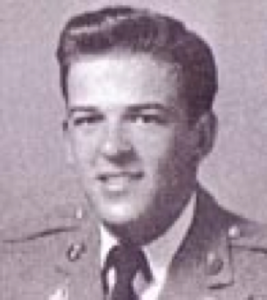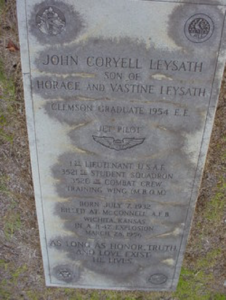Scroll of Honor – John Coryell Leysath
A Life of Outstanding Accomplishment
John Coryell Leysath grew up in the Orangeburg County  crossroads of North, South Carolina, graduating from the public schools there and belonging to the Methodist Church. He was the town’s first Eagle Scout and when it came time for college, he selected the small military school in the northwest corner of the state at Clemson.
crossroads of North, South Carolina, graduating from the public schools there and belonging to the Methodist Church. He was the town’s first Eagle Scout and when it came time for college, he selected the small military school in the northwest corner of the state at Clemson.
Better known as Jack, Leysath excelled on campus just as he had at home. He joined the Rifle Team and by his the end of his sophomore year was its captain and one of its high scorers. An electrical engineering major, Jack was active with the Wesley Foundation, the Tri County Club and the American Institute of Electrical Engineers. He was an ROTC student, participating in summer training at Tyndall Air Force Base in Florida before being designated as a Distinguished Military Graduate.
Following graduation from Clemson in 1954, Jack Leysath took a job with General Electric. He reported for active duty with the Air Force at Camp Sampson, New York that August and was later sent to Hondo Air Force Base and Webb Air Force Base, both in Texas. While at Webb, Leysath earned his jet pilot diploma. He was next assigned to McDill Air Force Base near Tampa, Florida where he was promoted to first lieutenant. Then, Leysath received orders assigning him for temporary duty at McConnell Air Force Base near Wichita, Kansas.
McConnell Air Force Base was a fairly new post, having been activated due to its proximity to Boeing’s Wichita factory that was then producing the B-47 Stratojet, the first swept-winged jet bomber built in quantity for the Air Force. With the new jets coming right off Boeing’s assembly line, McConnell was an ideal location for the conduct of combat crew training.
On March 28, 1956, Jack Leysath climbed aboard a B-47 commanded by instructor pilot Captain William Craggs. Joining First Lieutenant Leysath as a student was Lieutenant Colonel William Dames.
The B-47 Stratojet had been designed to fly at high subsonic speed and at high  altitude to avoid enemy interceptor aircraft. Its primary mission was as a nuclear bomber capable of striking the Soviet Union. Initial mission profiles included the loft bombing of nuclear weapons. In loft bombing, the attacking bomber pulls upward when releasing its bomb load, adding to the bomb’s flight time and giving the aircraft extra time to get away from the blast effects of the bomb, particularly important if the bomb is a nuclear device. The problem with loft bombing is that its repetition in training stresses the airframe and may cause metal fatigue.
altitude to avoid enemy interceptor aircraft. Its primary mission was as a nuclear bomber capable of striking the Soviet Union. Initial mission profiles included the loft bombing of nuclear weapons. In loft bombing, the attacking bomber pulls upward when releasing its bomb load, adding to the bomb’s flight time and giving the aircraft extra time to get away from the blast effects of the bomb, particularly important if the bomb is a nuclear device. The problem with loft bombing is that its repetition in training stresses the airframe and may cause metal fatigue.
Shortly after Captain Craggs and his two student pilots took off, as the aircraft reached about 2,000 feet in altitude, a Navy pilot flying nearby saw the B-47’s wings shear off. The Navy pilot said there was a fire in the bomber’s mid-section and then an explosion. The bomber crashed about four miles northeast of Wichita. All three crewmen were killed.
Jack Leysath was returned to North where he was buried with full military honors  in Pen Branch Cemetery. He was survived by his parents, Mr. and Mrs. Horace H. Leysath, one sister and one brother. In its obituary of the young lieutenant, The State newspaper wrote that his was “a life of outstanding accomplishment.”
in Pen Branch Cemetery. He was survived by his parents, Mr. and Mrs. Horace H. Leysath, one sister and one brother. In its obituary of the young lieutenant, The State newspaper wrote that his was “a life of outstanding accomplishment.”
For additional information about First Lieutenant John Coryell Leysath visit: https://soh.alumni.clemson.edu/scroll/john-coyell-leysath/
For more information about Clemson University’s Scroll of Honor see:
https://soh.alumni.clemson.edu/
